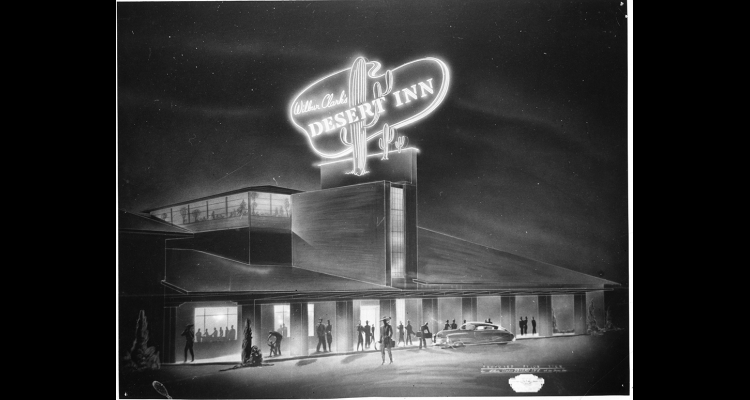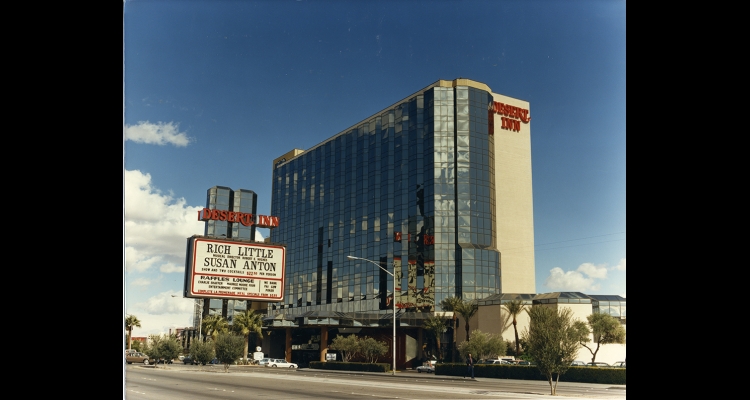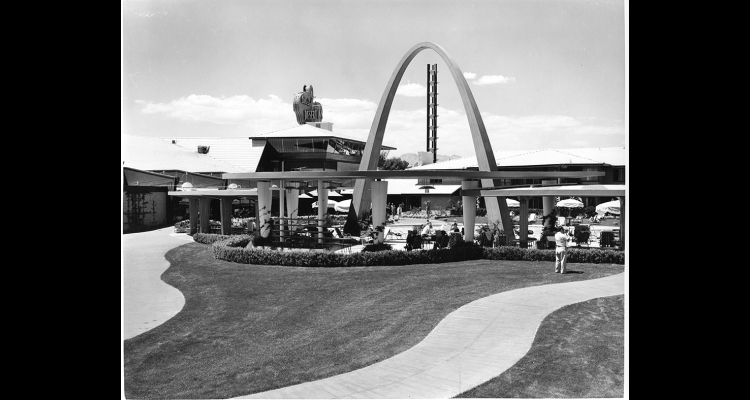Desert Inn
Wilbur Clark was operating several bars and a hotel in San Diego, California in 1944 when he learned that the El Rancho Vegas hotel-casino on the emerging Las Vegas Strip was up for sale. Clark, who for years had his eye on running a casino, sold his interests and moved to Las Vegas. He quickly acquired a majority stake in the western ranch-themed El Rancho, and he also invested in the Monte Carlo casino downtown and the Player's Club on Highway 91. The one-time kitchen worker and casino dealer from Illinois really wanted to design and build his own resort, which he would call the Desert Inn. With his project, Clark was one of the first to envision Las Vegas as a leading post-war venue for casino gaming and name entertainers from New York and Hollywood.
In 1946, Clark sold the El Rancho for $1.5 million and along with his brother and two other partners, began planning the Desert Inn. At the same time, William "Billy" Wilkerson and partner Ben "Bugsy" Siegel were constructing the Flamingo, and another investor was planning the Thunderbird hotel.
Clark, who started building in May 1947, ran out of money due to high post-war construction costs, and his deserted-looking building site became a joke to locals for months. Meanwhile, the Flamingo—with crucial financial backing provided by Siegel and other East Coast mob figures—laid claim to being the first new, post-war Strip casino to debut with gaming and top entertainers. The Flamingo opened in December 1946, featuring well-known bandleader Xavier Cugat and soon, film comedians Abbott and Costello, who were paid an-unheard-of $25,000 a week.
Badly in need of additional funds to complete his Desert Inn project, Clark turned to Moe Dalitz, a former illegal liquor bootlegger from Cleveland, Ohio, with ties to top organized crime figures. Dalitz, who ran the so-called Mayfield Road Gang of gambling racketeers in Cleveland, bought a seventy-five-percent interest in the Desert Inn from Clark in 1948.
The backing of the so-called "Cleveland Group" ensured the eventual launch of Wilbur Clark's Desert Inn, as it appeared on the hotel's distinctive neon sign, along with pictures of desert cacti. The Miami-style Bermuda-pink and green resort opened, at a cost of $6.5 million, on April 24, 1950. Radio comedian and ventriloquist Edgar Bergen, film star Vivian Blaine, the Desert Inn Orchestra, and others performed in the Painted Desert showroom for $25,000 a week. The upstairs Sky Room restaurant overlooked the "Dancing Waters," rising and falling fountains set to recorded music and lit by colored lights inside a figure-eight pool. Each of the Desert Inn's 300 hotel rooms was air conditioned by individual thermostats. A chef from the famed Ritz Hotel in Paris oversaw the gourmet restaurant. Dalitz's man, Allard Rosen, managed the casino.
In 1951, Clark began construction on a million-dollar, 165-acre, eighteen-hole golf course. Dubbed "Wilbur's Folly" by local skeptics, the course featured the first links on the Strip. Clark brought added publicity to the Desert Inn in 1953 by sponsoring the annual Tournament of Champions, a professional charity golf event that lured celebrities to the course and high-roller gamblers to the casino. Many continued to doubt Clark's actual participation in the running of the Desert Inn, calling him the "front man" who merely served to distract from the Dalitz group.
The Desert Inn's opulence soon attracted many celebrities and dignitaries including former president Harry Truman, the Duke and Duchess of Windsor, Winston Churchill, Adlai Stevenson, and then-U.S. Senator John F. Kennedy. The "D.I.," as it was nicknamed, helped establish Las Vegas as a national showcase for major talent in the 1950s with headliners such as Ed Sullivan, Betty Hutton, Noel Coward, and Jimmy Durante.
The Desert Inn was one of the most venerated hotel-casinos on the Strip despite allegations that the Dalitz group regularly underreported the money collected by the casino. The practice known as skimming concealed the involvement of hidden outside partners who sought to conceal their shares and avoid paying taxes. Clark sold his interest in the hotel in 1964, died from heart failure a year later. In the hands of Dalitz and his dubious associates, the Desert Inn attracted controversy that inspired FBI surveillance for years.
In November 1966, former aviator and eccentric multimillionaire Howard Hughes—then considered the richest man in America—checked into the Desert Inn's top-floor penthouse. Hughes liked the apartment, stayed for several weeks, and declined Dalitz's request for him to leave. He is said to have casually asked Dalitz what he wanted for the Desert Inn, and when Dalitz immediately answered with an inflated figure of $14.6 million, Hughes agreed to buy it and took over in April 1967.
Hughes' purchase meant that Dalitz's group, and the controversies over mob ties that drew national attention to Las Vegas for two decades, was on its way out and the respected investor Hughes was in. Secret skimming of casino proceeds by hotel employees loyal to Dalitz is said to have continued for a time, without the knowledge of Hughes or his less-experienced management team.
Hughes purchased other hotels on the Strip, and approved plans to enhance the Desert Inn property. In the throes of mental illness, he remained in the penthouse, with darkened windows, until 1976 when he quietly left town and died later that year. The Desert Inn remained in the hands of Hughes' company, the Summa Corporation, until 1987. The company invested $54 million to expand the hotel grounds and add the fourteen-floor Augusta Tower.
Despite a succession of owners until 2000, the aging hotel-casino failed to show a profit. Finally, just four days after the Desert Inn's fiftieth anniversary, developer Steve Wynn purchased the property at a cost of $275 million. Wynn, a former operator of the Mirage, Treasure Island, and Bellagio hotels on the Strip, closed the Desert Inn for good on August 28, 2000. The famous hotel-casino was imploded, starting with the Augusta Tower, in October 2001, to make way for Wynn Las Vegas. The $2.7 billion, 2,700-room resort opened on April 27, 2005, three days after the fifty-fifth anniversary of the original D.I. Wynn's major partner in the hotel company was Japanese gaming machine magnate, Kazuo Okada. Wynn kept and renovated the Desert Inn's original golf course.
Article Locations
Related Articles
None at this time.
Further Reading
None at this time.




